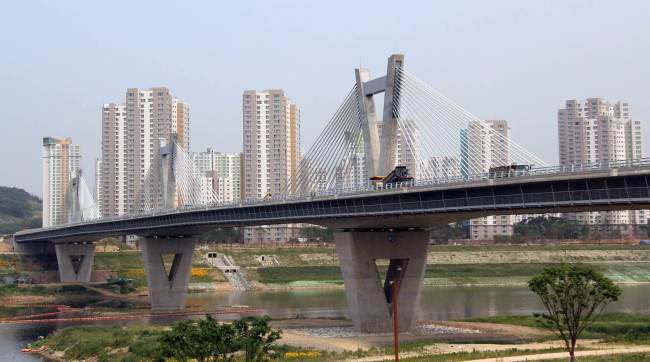This is the first in a series of articles on Sejong City, a new multifunctional administrative city to be launched on July 1. ― Ed.
After a decade of twists and turns, a project to build a new administrative hub over a hundred kilometers south of Seoul has become reality.
With much fanfare, government officials are to proclaim the official opening of Sejong City in South Chungcheong Province on July 1.
“Sejong is a symbol of the country’s efforts toward more balanced regional development. We must make sure it becomes a success,” said Home Administration Minister Maeng Hyung-gyu on a recent visit to a construction site in the planned city.

The first housing district of Sejong City is seen behind a bridge. ( Yonhap News)
Officials hope that the new city will help decongest Seoul and spur investment in the country’s central region.
Sejong City is a 22.5 trillion won project, including some 8.5 trillion won of state funds. So far, nearly 40 percent of the budget has been executed.
Spanning over 465 square kilometers of land, Sejong is about 70 percent the size of Seoul. It is currently in the first stage of its development plan, erecting a cluster of concrete buildings to be used as government agencies.
From September till 2014, a total of 36 central government offices, including nine ministries, and 16 state-run organizations will move into the area. First to move is the Prime Ministers’ Office.
By the end of the year, six more will follow, including the finance and environmental ministries.
Over 10,000 government officials will reside in the city, once the relocation is complete. As the city develops under the second- and third-phases, the population is projected to reach 500,000 by 2030.
The city’s first village opened late last year and now has about 2,000 households and four schools.
A decade of controversy
The idea to build Sejong was first floated by late President Roh Moo-hyun in September 2002 as a presidential campaign pledge.
His idea was to relieve the overcrowding of Seoul by moving the country’s capital to the central provinces of Chungcheong.
With Roh elected, in part thanks to strong support from Chungcheong voters, the government set in motion the capital relocation plan. A legislative bill for the move passed through the National Assembly in December 2003.
Roh’s plan, however, faced a major setback when the Constitutional Court, acting on a complaint filed by the then-opposition Grand National Party, now Saenuri Party, ruled in October 2004 that the nation’s capital must remain in Seoul.
Following the decision, the Roh administration watered down the plan to relocate many but not all government offices to Sejong, branding it as a new administrative city, not a new capital. The revised plan was approved by the parliament in March 2005. Opponents challenged the altered plan, filing a complaint with the Constitutional Court, but the court rejected it in November 2005.
The Sejong City plan faced another challenge under a new administration led by incumbent President Lee Myung-bak in 2008.
Lee opposed the idea of moving government agencies out of Seoul, saying it would hurt the capital’s global competitiveness and result in inefficiency. Instead, he proposed a new vision for Sejong as an industrial, science and education hub.
Roh’s allies, now in the opposition, vehemently opposed the proposed alteration. Some within the ruling GNP, including Lee’s archrival Park Geun-hye, also criticized the president for betraying Chungcheong voters.
After a defeat in local elections in mid-2010, Lee finally threw in the towel and asked the National Assembly to decide. In June 2010, the National Assembly voted down his proposal, finally putting to an end a decade-long political debate over Sejong.
Lingering doubts
Despite the closure to political wrangling over Sejong, doubts remain as to whether the new city will grow into a self-sustainable town, not to mention serving its stated goal of balanced regional development.
In February this year, the Board of Audit and Inspection painted a grim picture for Sejong City, saying it has little potential to become a self-contained city.
It said the city is unlikely to have the targeted population of 500,000 by 2030, as it failed to attract private construction investment, necessary for creating a viable residential complex. It cited insufficient benefits for private investors as such as tax incentives and government subsidies as the main reason.
For Sejong to grow into a prosperous city, experts see it as vital to have a competitive living environment to draw people from Seoul and nearby areas.
“The most urgent task for Sejong is to make it a place where government officials would like to settle down with their entire family,” said Lee Chang-moo, professor at Hanyang University in Seoul.
Song Ki-sup, chairman of the Multifunctional Administrative City Construction Agency, said aside from the administrative function, Sejong is designed to serve as the country’s new center of education, science and high-tech industries.
“Above all, our ultimate goal is to make Sejong a place that people love to live in,” he said. MACCA is a special governmental unit established to oversee the planning and construction of the city.
“Sejong is to have all the finest elements of urban planning. It will have the widest green space in it, compared to any other city in Korea, utilize the latest technologies for city management such as traffic control and the finest schools,” Song said.
By Lee Sun-young (milaya@heraldcorp.com)



![[Herald Interview] 'Amid aging population, Korea to invite more young professionals from overseas'](http://res.heraldm.com/phpwas/restmb_idxmake.php?idx=645&simg=/content/image/2024/04/24/20240424050844_0.jpg&u=20240424200058)


